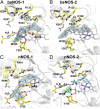Structural and biological studies on bacterial nitric oxide synthase inhibitors
- PMID: 24145412
- PMCID: PMC3831449
- DOI: 10.1073/pnas.1314080110
Structural and biological studies on bacterial nitric oxide synthase inhibitors
Abstract
Nitric oxide (NO) produced by bacterial NOS functions as a cytoprotective agent against oxidative stress in Staphylococcus aureus, Bacillus anthracis, and Bacillus subtilis. The screening of several NOS-selective inhibitors uncovered two inhibitors with potential antimicrobial properties. These two compounds impede the growth of B. subtilis under oxidative stress, and crystal structures show that each compound exhibits a unique binding mode. Both compounds serve as excellent leads for the future development of antimicrobials against bacterial NOS-containing bacteria.
Keywords: antibiotics; crystallography.
Conflict of interest statement
The authors declare no conflict of interest.
Figures



Similar articles
-
Structure-based design of bacterial nitric oxide synthase inhibitors.J Med Chem. 2015 Jan 22;58(2):994-1004. doi: 10.1021/jm501723p. Epub 2015 Jan 6. J Med Chem. 2015. PMID: 25522110 Free PMC article.
-
Inhibitor Bound Crystal Structures of Bacterial Nitric Oxide Synthase.Biochemistry. 2015 Jul 7;54(26):4075-82. doi: 10.1021/acs.biochem.5b00431. Epub 2015 Jun 23. Biochemistry. 2015. PMID: 26062720 Free PMC article.
-
Identification of redox partners and development of a novel chimeric bacterial nitric oxide synthase for structure activity analyses.J Biol Chem. 2014 Oct 17;289(42):29437-45. doi: 10.1074/jbc.M114.595165. Epub 2014 Sep 6. J Biol Chem. 2014. PMID: 25194416 Free PMC article.
-
Nitric oxide synthase and structure-based inhibitor design.Nitric Oxide. 2017 Feb 28;63:68-77. doi: 10.1016/j.niox.2016.11.004. Epub 2016 Nov 23. Nitric Oxide. 2017. PMID: 27890696 Free PMC article. Review.
-
Dissecting regulation mechanism of the FMN to heme interdomain electron transfer in nitric oxide synthases.J Inorg Biochem. 2014 Jan;130:130-40. doi: 10.1016/j.jinorgbio.2013.09.005. Epub 2013 Sep 13. J Inorg Biochem. 2014. PMID: 24084585 Free PMC article. Review.
Cited by
-
Nitric oxide synthase inhibitors that interact with both heme propionate and tetrahydrobiopterin show high isoform selectivity.J Med Chem. 2014 May 22;57(10):4382-96. doi: 10.1021/jm5004182. Epub 2014 May 7. J Med Chem. 2014. PMID: 24758147 Free PMC article.
-
Structure-based design of bacterial nitric oxide synthase inhibitors.J Med Chem. 2015 Jan 22;58(2):994-1004. doi: 10.1021/jm501723p. Epub 2015 Jan 6. J Med Chem. 2015. PMID: 25522110 Free PMC article.
-
Bacterial Nitric Oxide Synthase Is Required for the Staphylococcus aureus Response to Heme Stress.ACS Infect Dis. 2016 Aug 12;2(8):572-8. doi: 10.1021/acsinfecdis.6b00081. Epub 2016 Jul 7. ACS Infect Dis. 2016. PMID: 27626297 Free PMC article.
-
The Response of nor and nos Contributes to Staphylococcus aureus Virulence and Metabolism.J Bacteriol. 2019 Apr 9;201(9):e00107-19. doi: 10.1128/JB.00107-19. Print 2019 May 1. J Bacteriol. 2019. PMID: 30782631 Free PMC article.
-
Contribution of the nos-pdt operon to virulence phenotypes in methicillin-sensitive Staphylococcus aureus.PLoS One. 2014 Oct 2;9(9):e108868. doi: 10.1371/journal.pone.0108868. eCollection 2014. PLoS One. 2014. PMID: 25275514 Free PMC article.
References
-
- Sudhamsu J, Crane BR. Bacterial nitric oxide synthases: What are they good for? Trends Microbiol. 2009;17(5):212–218. - PubMed
-
- Moncada S, Palmer RM, Higgs EA. Nitric oxide: Physiology, pathophysiology, and pharmacology. Pharmacol Rev. 1991;43(2):109–142. - PubMed
-
- Griffith OW, Stuehr DJ. Nitric oxide synthases: Properties and catalytic mechanism. Annu Rev Physiol. 1995;57:707–736. - PubMed
-
- Calabrese V, et al. Nitric oxide in the central nervous system: Neuroprotection versus neurotoxicity. Nat Rev Neurosci. 2007;8(10):766–775. - PubMed
Publication types
MeSH terms
Substances
Associated data
- Actions
- Actions
- Actions
- Actions
Grants and funding
LinkOut - more resources
Full Text Sources
Other Literature Sources
Medical
Molecular Biology Databases

